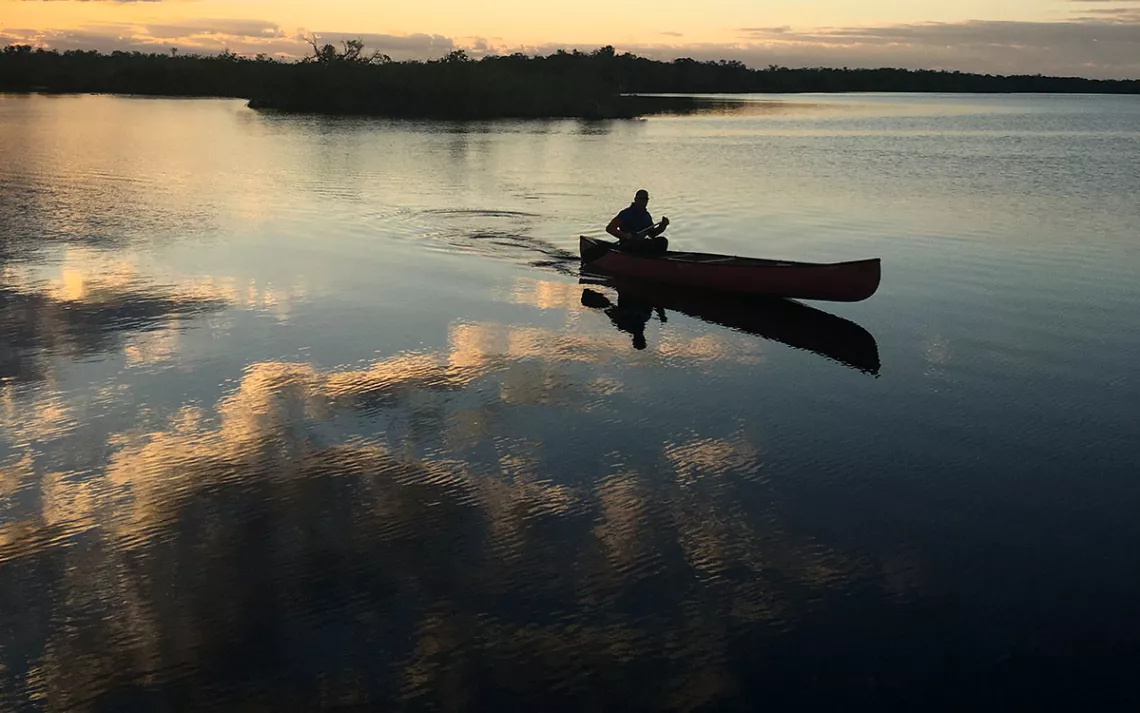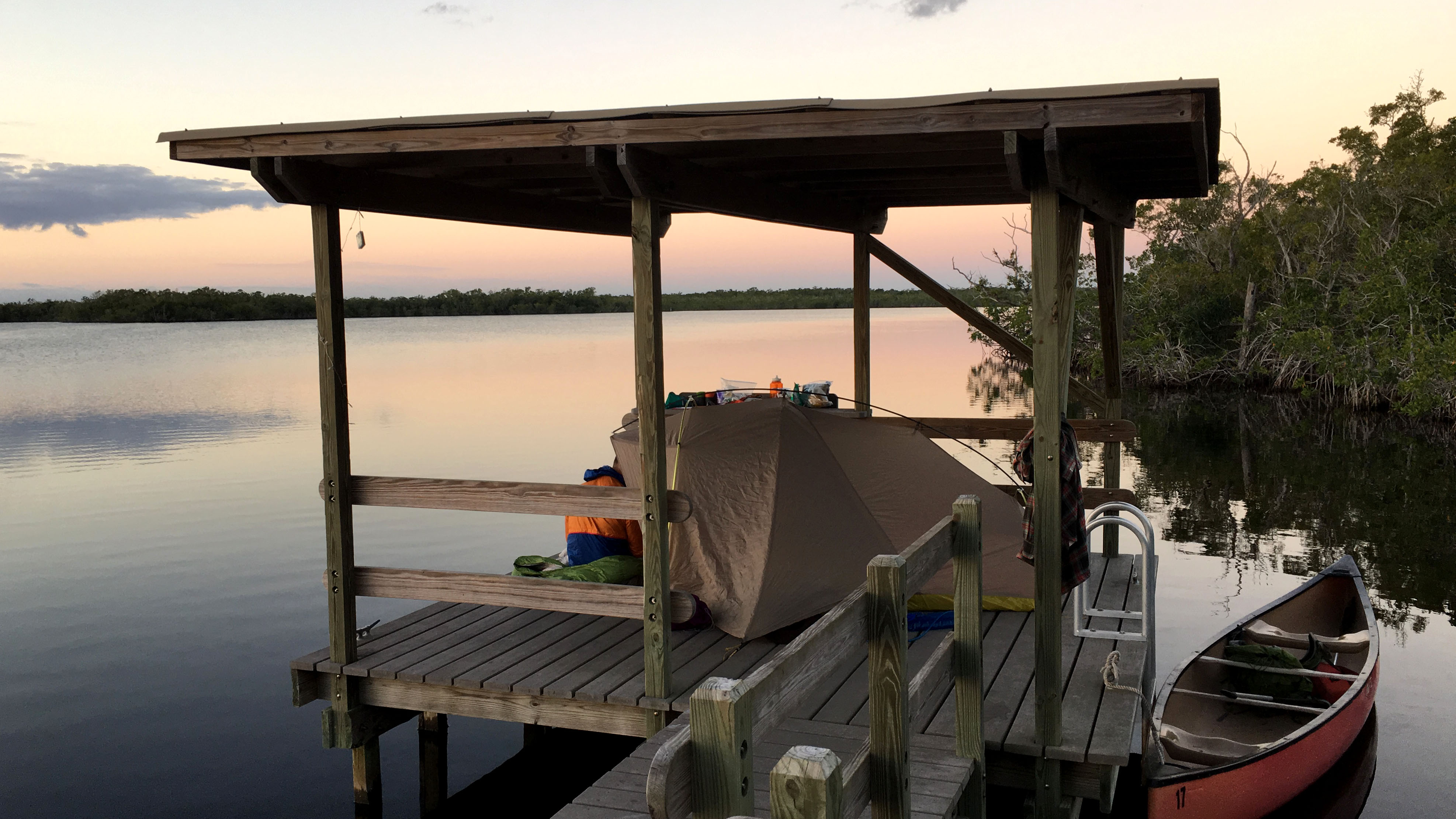To a (Picturesque) Hell and Back
Hell's Bay is a wildlife lover's dream—just watch out for alligators

Morning paddle in Everglades National Park | Photo by Ryan MacDonald
I was warned there could be alligators, so I'm on high alert as I paddle through the mazelike passageways of the Hell's Bay Canoe Trail. I grip my paddle like it's a battle ax, prepared to take down anything in my path. When something beneath the canoe sends me hurtling out of my front seat and nearly into the water, I flail like a nestling chick preparing for flight before catching myself on the edge of my boat. Wrestling aside branches and slicing down vines, I regain my equilibrium and steady the bow of my 17-foot vessel. With a trail of vegetation in my wake, I paddle on.
Florida old-timers warn that taking this route is “hell to get into, and hell to get out of,” and they aren’t exaggerating. After an hour of paddling, my fear of being attacked by a gator has dissolved into utter frustration. Luckily, I’m not alone in this misery. My partner, Richard, and some longtime friends have joined me for this two-day expedition into the swamps of Everglades National Park.
Our goal is to paddle the entire 5.5-mile loop and then camp on a backcountry chickee—an elevated, wooden platform that sits above open water. Getting there is the trick. The route requires navigating an endless series of narrow corridors that comprise the largest mangrove ecosystem in the Western Hemisphere. These tropical forests provide shelter and sanctuary for many of the region’s rare and endangered marine mammals and wildlife, like the manatee and American crocodile, and occupy a large portion of the park’s 1.5 million acres of wetlands.
Located on the southern tip of Florida, Everglades is among the top 10 largest U.S. national parks (larger than Grand Canyon but smaller than Yellowstone) and hosts more than a million visitors annually who come to explore the variety of ecosystems that are created by the water flow from Lake Okeechobee, the state’s largest freshwater lake. Because of climate change, some of these habitats are becoming threatened. In 2016, a record amount of rainfall from El Niño caused flooding in parts of the park, and rising sea levels are contributing to the salinization of the park’s groundwater.
But the mangrove trees remain resilient. Their root systems, which are adapted to saline waters, withstand the daily rise and fall of tides and are the first line of defense against hurricanes that hit this region every year. As I attempt to forge my way through the mangroves, I learn through a series of trial and error that they don’t bend, snap, or break away easily. Rather than using brute force to power through their dense and stilt-like webs, I rely on them as a resource. I grab them to steer around sharp turns, and I let their branches slow our pace rather than try to avoid colliding with them.
Eventually these claustrophobic pathways widen into broad canals and we pick up speed and synchronize our paddling. As I paddle through our second and third miles, I begin to mindlessly chant, “right, left, right, left,” though no one is listening. I drop into a meditative trance, the way I do on a long incline up a mountain. As the landscape evolves, I can see why naturalists have nicknamed this place “the river of grass”: Blades of sawgrass and other plants reach up from below the water’s surface and create a trail of their own making. In some areas of the park, there are marshes so thick and tall of these sedges that the water below disappears completely.
The park ranger at the Flamingo Visitor Center said that, if we were lucky, we might spot a pod of bottlenose dolphins that like to hang out near our campsite. After docking our boats, we sit on the edge of our chickee and wait patiently for the marine mammals’ arrival. But our hopes eventually fade to disappointment. We see nothing, and I figure that the local pod has migrated someplace else for the winter. Only a chorus of cicadas keeps us company as we zip up our tents and say goodnight.

Sunrise from a backcountry chickee | Photo by Ryan MacDonald
The next day, I launch my canoe before dawn for a morning paddle. My first paddle stroke breaks the glassy stillness of the bay and fractures the reflection in the water. A graceful pink bird with a massive wingspan soars directly over my path, and I scream in excitement at the sight of some wildlife. “It’s a flamingo,” I shout. Only later do I realize what I saw was a roseate spoonbill, a long-billed wading bird that roosts in the park during winter. In recent years, the number of nesting spoonbills within the park has declined dramatically, so I’m happy to have spotted one.
After breakfast, our whole crew is back on the water again. I’m scanning the bay for our next trail marker when my friends whisper from their boat to look over my right shoulder. Our hopes have finally paid off: A pair of dolphins has popped up from below the water surface. I whistle to get their attention, but they keep their distance, if they notice our boats at all. I try to follow their progress across the length of what seems like a football field, but their ability to hold their breath is longer than my eyesight, and after that one glimpse there’s no other sign of them.
The way back is much easier than the route in, or maybe we’ve acclimated to the unruly challenges of the water route, and soon enough (all too soon, in fact) we are back at the visitor center. On the drive out of the park, a line of cars stops traffic and I watch several people jump out of their vehicles to snap selfies with a 10-foot-long alligator sprawled across the highway. My anxiety roars back knowing one of these creatures could have been lurking underneath our campsite the entire night.
This time, I’m the one keeping the distance. I don’t even push the gas pedal until the alligator slithers away out of sight.
Follow in the Paddle Strokes
Where: Everglades National Park, Hell’s Bay Canoe Trail, Florida
Getting There: From Miami, take the Florida Turnpike south until it merges with US 1 in Florida City, then follow the signs into the park. This 5.5-mile, out-and-back trail is located off State Highway 9336. Canoes and kayaks can be launched into the water directly from the road.
Best Time to Visit: The “dry” season runs from December through April. Temperatures rise to the mid-70s during the day and drop into the 50s at night. Higher temperatures, pesky mosquitoes, and humidity keep most visitors away from the park between May and November.
Permits: Day permits and overnight backcountry chickees can be reserved up to one day in advance at the Flamingo Visitor Center. No online reservations are available. Canoes, kayaks, and other gear can be rented at the Flamingo Marina Store, located next to the visitor center. Both chickee platforms have two sleeping areas, which fit up to two tents.
Survival Tip: Pay close attention to the trail markers, which are a series of 160 PVC numbered poles sticking up above the waterline. Placed sporadically along the route, they often blend in with the mangrove trees, and some have been knocked over.
Wildlife Spotting: Bottlenose dolphins, roseate spoonbills, egrets, and many other birds can all be spotted here, but most of the wildlife comes out before sunrise. If the water stays warm through winter, manatees are known to meander through the backwaters.
 The Magazine of The Sierra Club
The Magazine of The Sierra Club



